Significance of Talent Management: Hilton Hotel Analysis
VerifiedAdded on 2023/01/13
|22
|6667
|98
Report
AI Summary
This report examines the significance of talent management within the hospitality industry, using Hilton Hotel as a case study. The research investigates the relationship between talent management practices and organizational performance, focusing on various approaches employed by Hilton's HR department. The study aims to understand the importance of talent management, identify key approaches, and analyze the challenges faced by leaders and HR professionals in developing talent management strategies, especially during crises like the COVID-19 pandemic. The report covers literature review, research methodology, data analysis, and findings, including both quantitative and qualitative data, to provide a comprehensive overview of talent management's impact. The research also explores challenges such as adapting leadership styles, providing adequate compensation, and recruiting talent in a competitive market. The conclusion summarizes the key findings, contributions, limitations, and recommendations for future research.
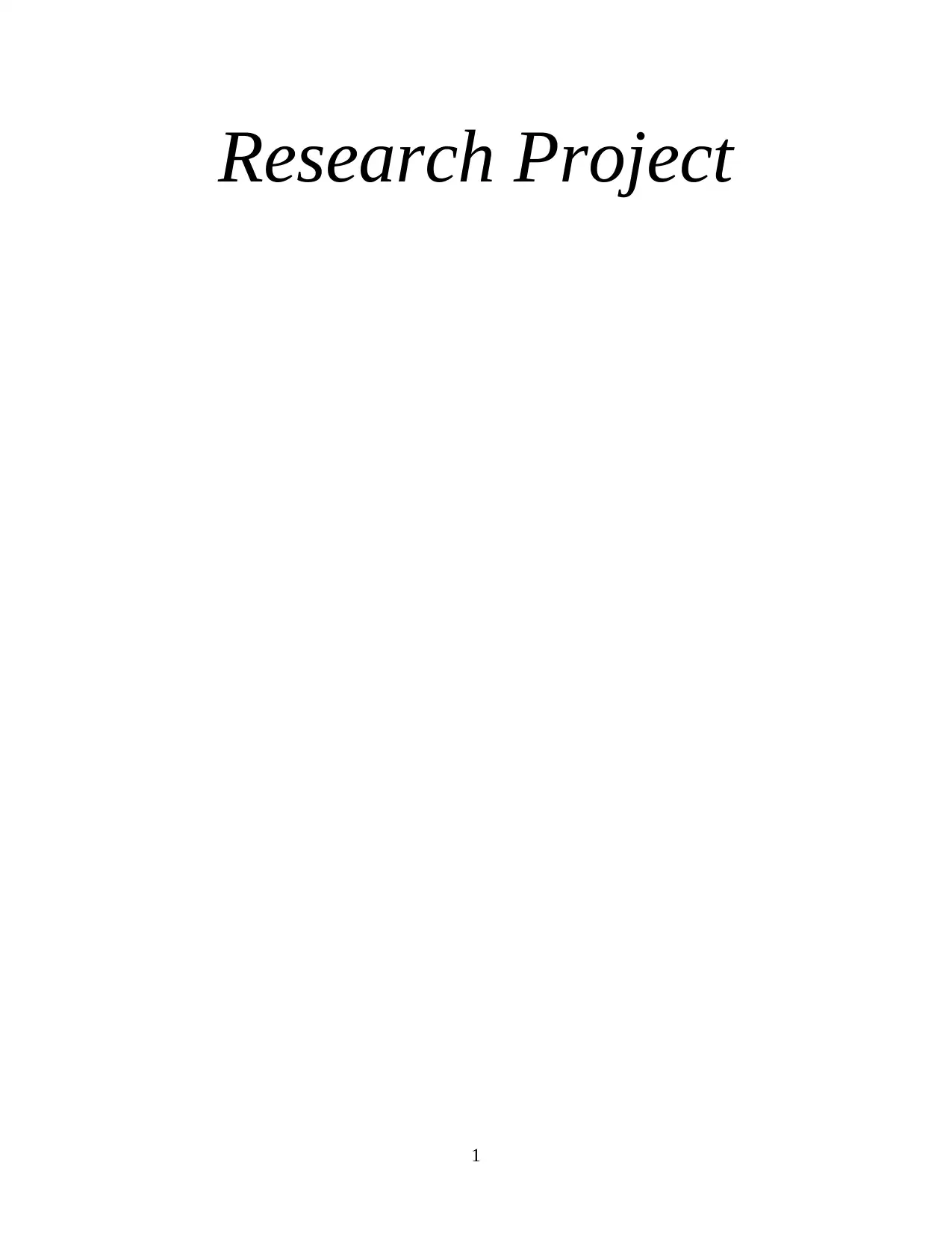
Research Project
1
1
Paraphrase This Document
Need a fresh take? Get an instant paraphrase of this document with our AI Paraphraser
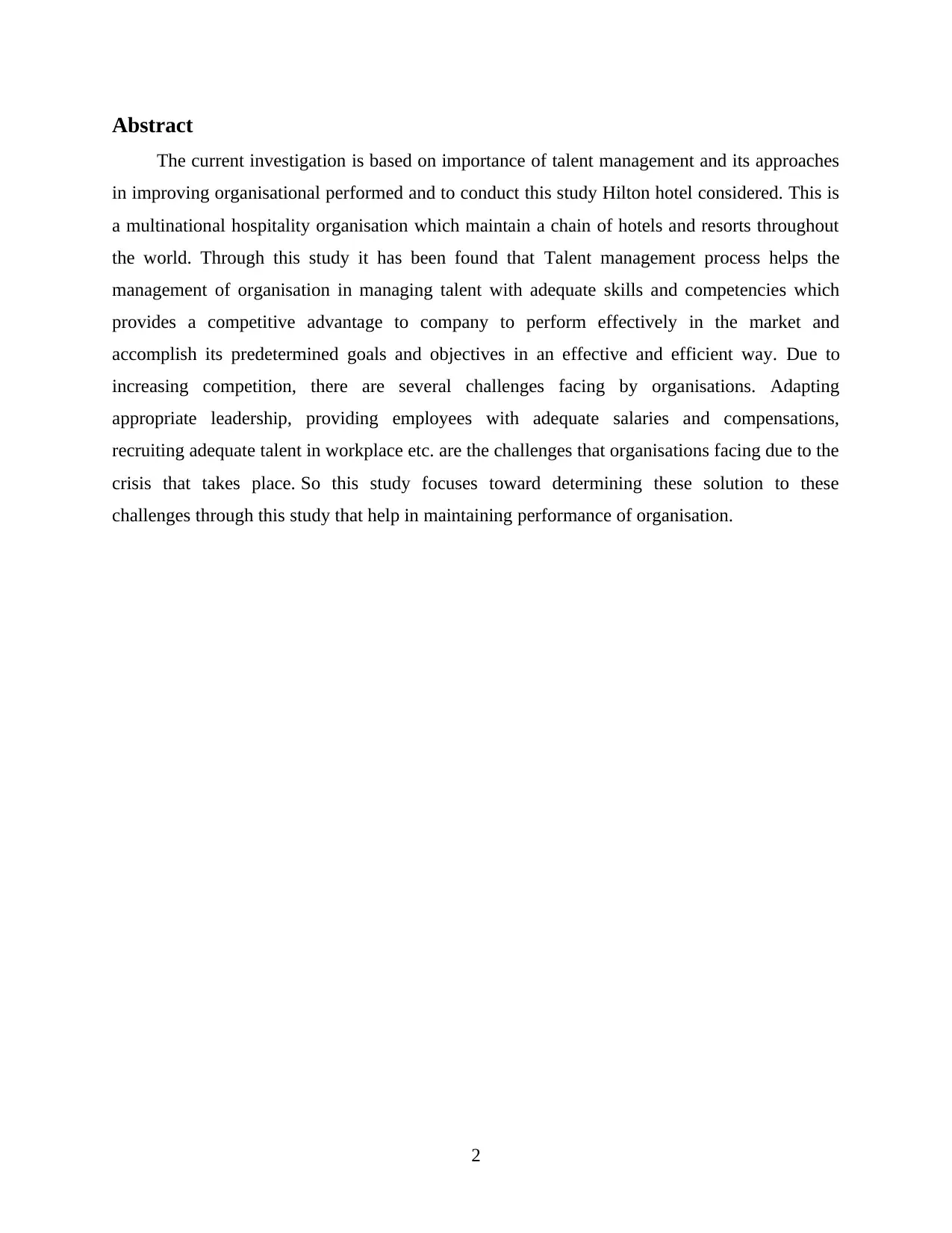
Abstract
The current investigation is based on importance of talent management and its approaches
in improving organisational performed and to conduct this study Hilton hotel considered. This is
a multinational hospitality organisation which maintain a chain of hotels and resorts throughout
the world. Through this study it has been found that Talent management process helps the
management of organisation in managing talent with adequate skills and competencies which
provides a competitive advantage to company to perform effectively in the market and
accomplish its predetermined goals and objectives in an effective and efficient way. Due to
increasing competition, there are several challenges facing by organisations. Adapting
appropriate leadership, providing employees with adequate salaries and compensations,
recruiting adequate talent in workplace etc. are the challenges that organisations facing due to the
crisis that takes place. So this study focuses toward determining these solution to these
challenges through this study that help in maintaining performance of organisation.
2
The current investigation is based on importance of talent management and its approaches
in improving organisational performed and to conduct this study Hilton hotel considered. This is
a multinational hospitality organisation which maintain a chain of hotels and resorts throughout
the world. Through this study it has been found that Talent management process helps the
management of organisation in managing talent with adequate skills and competencies which
provides a competitive advantage to company to perform effectively in the market and
accomplish its predetermined goals and objectives in an effective and efficient way. Due to
increasing competition, there are several challenges facing by organisations. Adapting
appropriate leadership, providing employees with adequate salaries and compensations,
recruiting adequate talent in workplace etc. are the challenges that organisations facing due to the
crisis that takes place. So this study focuses toward determining these solution to these
challenges through this study that help in maintaining performance of organisation.
2
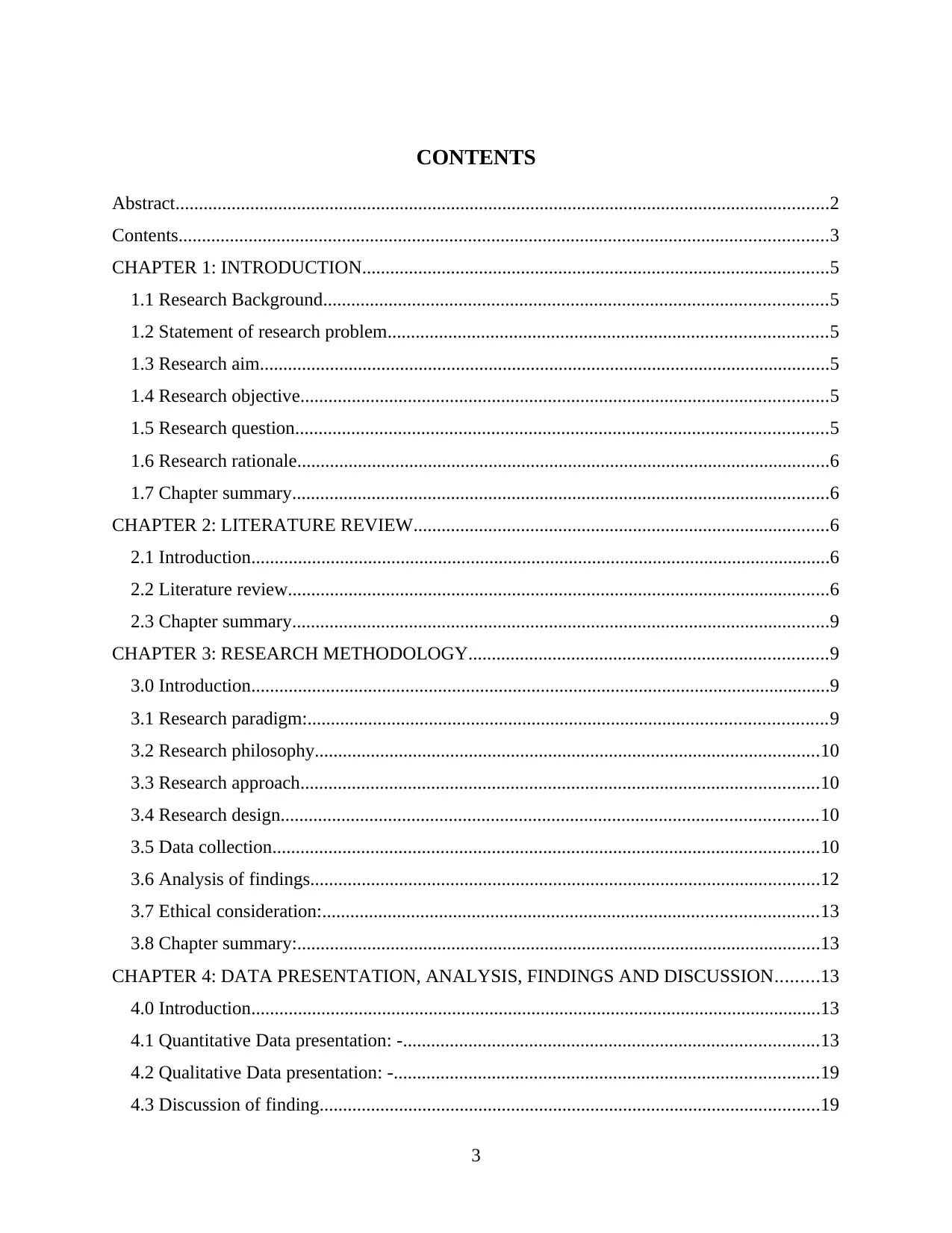
CONTENTS
Abstract............................................................................................................................................2
Contents...........................................................................................................................................3
CHAPTER 1: INTRODUCTION....................................................................................................5
1.1 Research Background............................................................................................................5
1.2 Statement of research problem..............................................................................................5
1.3 Research aim..........................................................................................................................5
1.4 Research objective.................................................................................................................5
1.5 Research question..................................................................................................................5
1.6 Research rationale..................................................................................................................6
1.7 Chapter summary...................................................................................................................6
CHAPTER 2: LITERATURE REVIEW.........................................................................................6
2.1 Introduction............................................................................................................................6
2.2 Literature review....................................................................................................................6
2.3 Chapter summary...................................................................................................................9
CHAPTER 3: RESEARCH METHODOLOGY.............................................................................9
3.0 Introduction............................................................................................................................9
3.1 Research paradigm:...............................................................................................................9
3.2 Research philosophy............................................................................................................10
3.3 Research approach...............................................................................................................10
3.4 Research design...................................................................................................................10
3.5 Data collection.....................................................................................................................10
3.6 Analysis of findings.............................................................................................................12
3.7 Ethical consideration:..........................................................................................................13
3.8 Chapter summary:................................................................................................................13
CHAPTER 4: DATA PRESENTATION, ANALYSIS, FINDINGS AND DISCUSSION.........13
4.0 Introduction..........................................................................................................................13
4.1 Quantitative Data presentation: -.........................................................................................13
4.2 Qualitative Data presentation: -...........................................................................................19
4.3 Discussion of finding...........................................................................................................19
3
Abstract............................................................................................................................................2
Contents...........................................................................................................................................3
CHAPTER 1: INTRODUCTION....................................................................................................5
1.1 Research Background............................................................................................................5
1.2 Statement of research problem..............................................................................................5
1.3 Research aim..........................................................................................................................5
1.4 Research objective.................................................................................................................5
1.5 Research question..................................................................................................................5
1.6 Research rationale..................................................................................................................6
1.7 Chapter summary...................................................................................................................6
CHAPTER 2: LITERATURE REVIEW.........................................................................................6
2.1 Introduction............................................................................................................................6
2.2 Literature review....................................................................................................................6
2.3 Chapter summary...................................................................................................................9
CHAPTER 3: RESEARCH METHODOLOGY.............................................................................9
3.0 Introduction............................................................................................................................9
3.1 Research paradigm:...............................................................................................................9
3.2 Research philosophy............................................................................................................10
3.3 Research approach...............................................................................................................10
3.4 Research design...................................................................................................................10
3.5 Data collection.....................................................................................................................10
3.6 Analysis of findings.............................................................................................................12
3.7 Ethical consideration:..........................................................................................................13
3.8 Chapter summary:................................................................................................................13
CHAPTER 4: DATA PRESENTATION, ANALYSIS, FINDINGS AND DISCUSSION.........13
4.0 Introduction..........................................................................................................................13
4.1 Quantitative Data presentation: -.........................................................................................13
4.2 Qualitative Data presentation: -...........................................................................................19
4.3 Discussion of finding...........................................................................................................19
3
⊘ This is a preview!⊘
Do you want full access?
Subscribe today to unlock all pages.

Trusted by 1+ million students worldwide
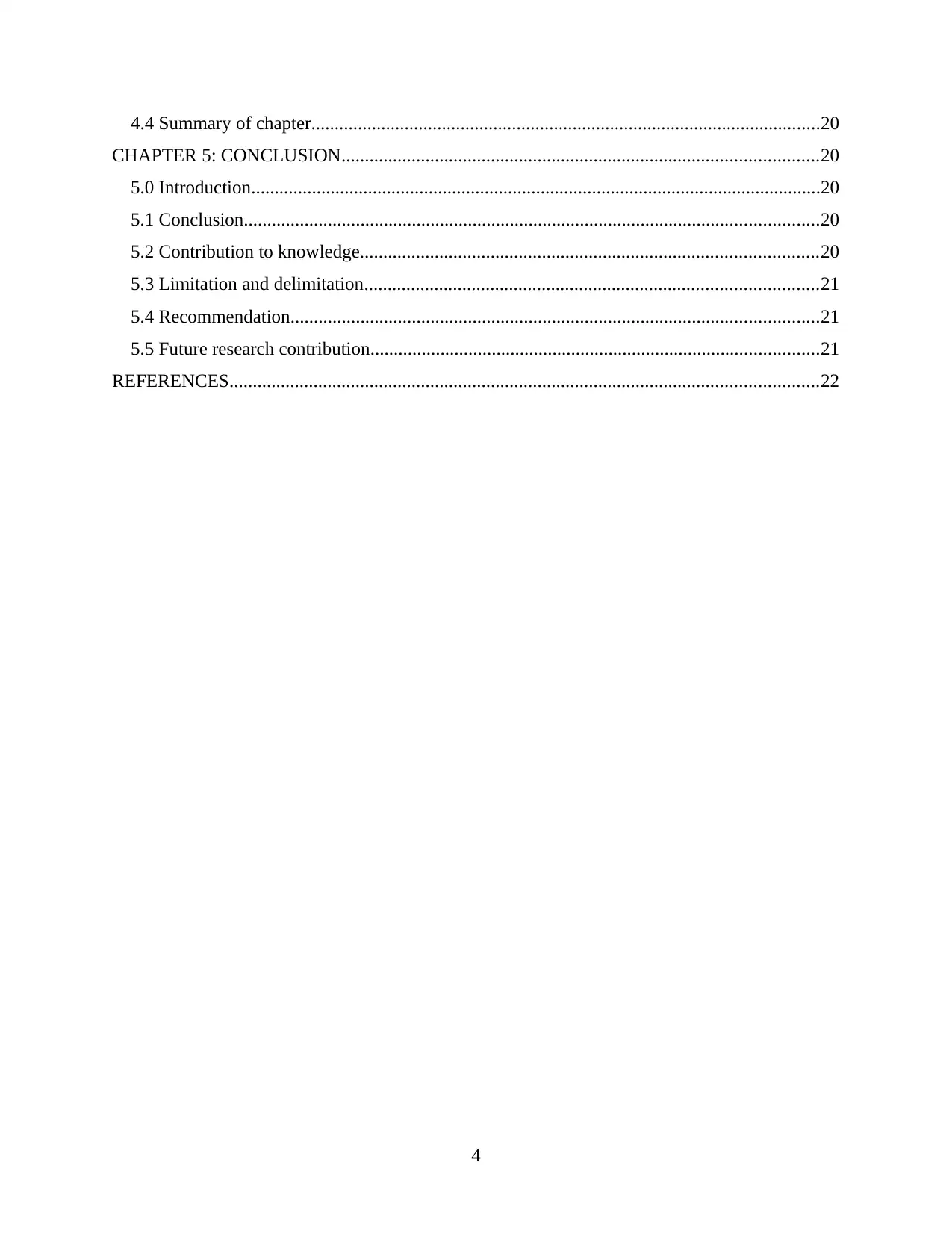
4.4 Summary of chapter.............................................................................................................20
CHAPTER 5: CONCLUSION......................................................................................................20
5.0 Introduction..........................................................................................................................20
5.1 Conclusion...........................................................................................................................20
5.2 Contribution to knowledge..................................................................................................20
5.3 Limitation and delimitation.................................................................................................21
5.4 Recommendation.................................................................................................................21
5.5 Future research contribution................................................................................................21
REFERENCES..............................................................................................................................22
4
CHAPTER 5: CONCLUSION......................................................................................................20
5.0 Introduction..........................................................................................................................20
5.1 Conclusion...........................................................................................................................20
5.2 Contribution to knowledge..................................................................................................20
5.3 Limitation and delimitation.................................................................................................21
5.4 Recommendation.................................................................................................................21
5.5 Future research contribution................................................................................................21
REFERENCES..............................................................................................................................22
4
Paraphrase This Document
Need a fresh take? Get an instant paraphrase of this document with our AI Paraphraser
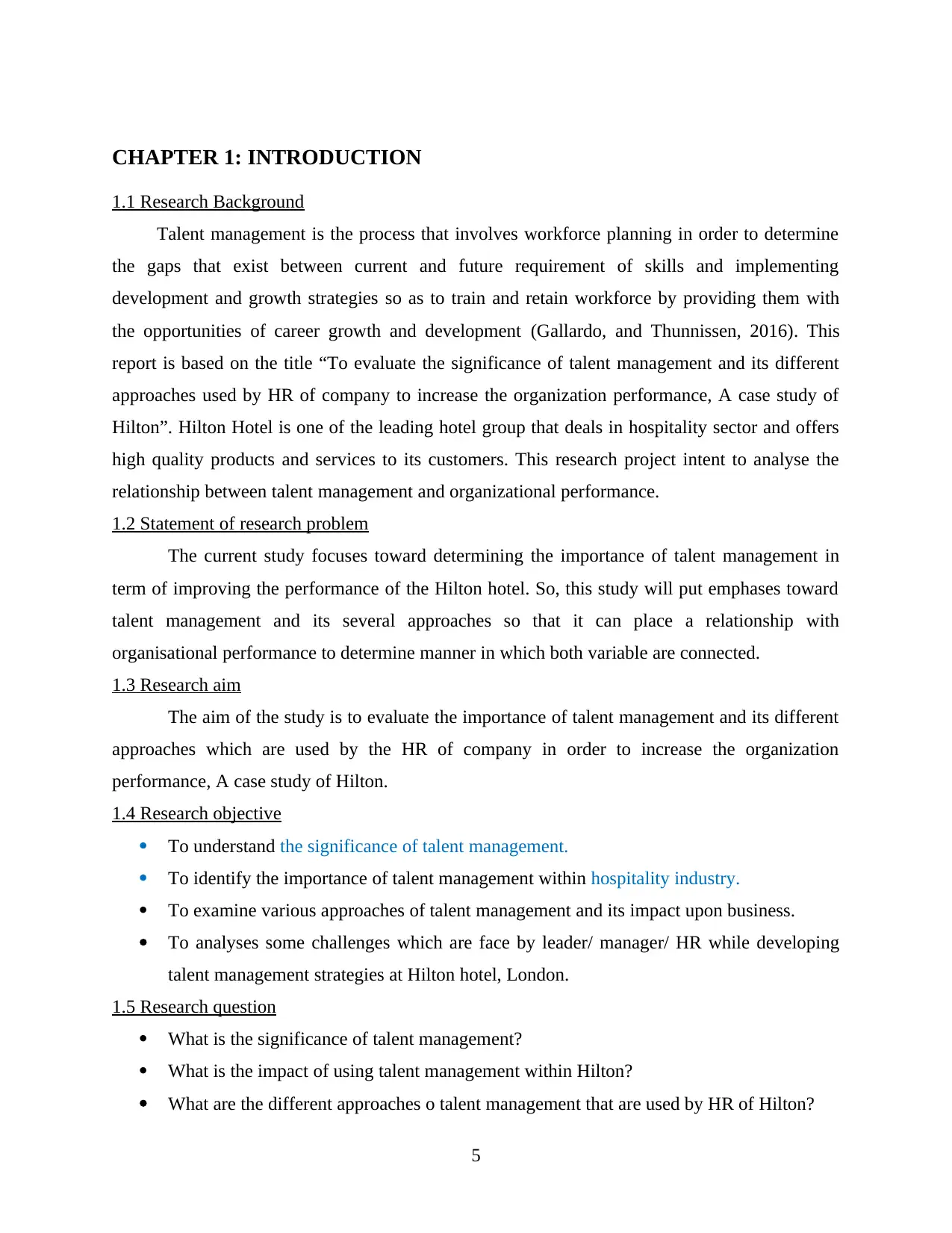
CHAPTER 1: INTRODUCTION
1.1 Research Background
Talent management is the process that involves workforce planning in order to determine
the gaps that exist between current and future requirement of skills and implementing
development and growth strategies so as to train and retain workforce by providing them with
the opportunities of career growth and development (Gallardo, and Thunnissen, 2016). This
report is based on the title “To evaluate the significance of talent management and its different
approaches used by HR of company to increase the organization performance, A case study of
Hilton”. Hilton Hotel is one of the leading hotel group that deals in hospitality sector and offers
high quality products and services to its customers. This research project intent to analyse the
relationship between talent management and organizational performance.
1.2 Statement of research problem
The current study focuses toward determining the importance of talent management in
term of improving the performance of the Hilton hotel. So, this study will put emphases toward
talent management and its several approaches so that it can place a relationship with
organisational performance to determine manner in which both variable are connected.
1.3 Research aim
The aim of the study is to evaluate the importance of talent management and its different
approaches which are used by the HR of company in order to increase the organization
performance, A case study of Hilton.
1.4 Research objective
To understand the significance of talent management.
To identify the importance of talent management within hospitality industry.
To examine various approaches of talent management and its impact upon business.
To analyses some challenges which are face by leader/ manager/ HR while developing
talent management strategies at Hilton hotel, London.
1.5 Research question
What is the significance of talent management?
What is the impact of using talent management within Hilton?
What are the different approaches o talent management that are used by HR of Hilton?
5
1.1 Research Background
Talent management is the process that involves workforce planning in order to determine
the gaps that exist between current and future requirement of skills and implementing
development and growth strategies so as to train and retain workforce by providing them with
the opportunities of career growth and development (Gallardo, and Thunnissen, 2016). This
report is based on the title “To evaluate the significance of talent management and its different
approaches used by HR of company to increase the organization performance, A case study of
Hilton”. Hilton Hotel is one of the leading hotel group that deals in hospitality sector and offers
high quality products and services to its customers. This research project intent to analyse the
relationship between talent management and organizational performance.
1.2 Statement of research problem
The current study focuses toward determining the importance of talent management in
term of improving the performance of the Hilton hotel. So, this study will put emphases toward
talent management and its several approaches so that it can place a relationship with
organisational performance to determine manner in which both variable are connected.
1.3 Research aim
The aim of the study is to evaluate the importance of talent management and its different
approaches which are used by the HR of company in order to increase the organization
performance, A case study of Hilton.
1.4 Research objective
To understand the significance of talent management.
To identify the importance of talent management within hospitality industry.
To examine various approaches of talent management and its impact upon business.
To analyses some challenges which are face by leader/ manager/ HR while developing
talent management strategies at Hilton hotel, London.
1.5 Research question
What is the significance of talent management?
What is the impact of using talent management within Hilton?
What are the different approaches o talent management that are used by HR of Hilton?
5
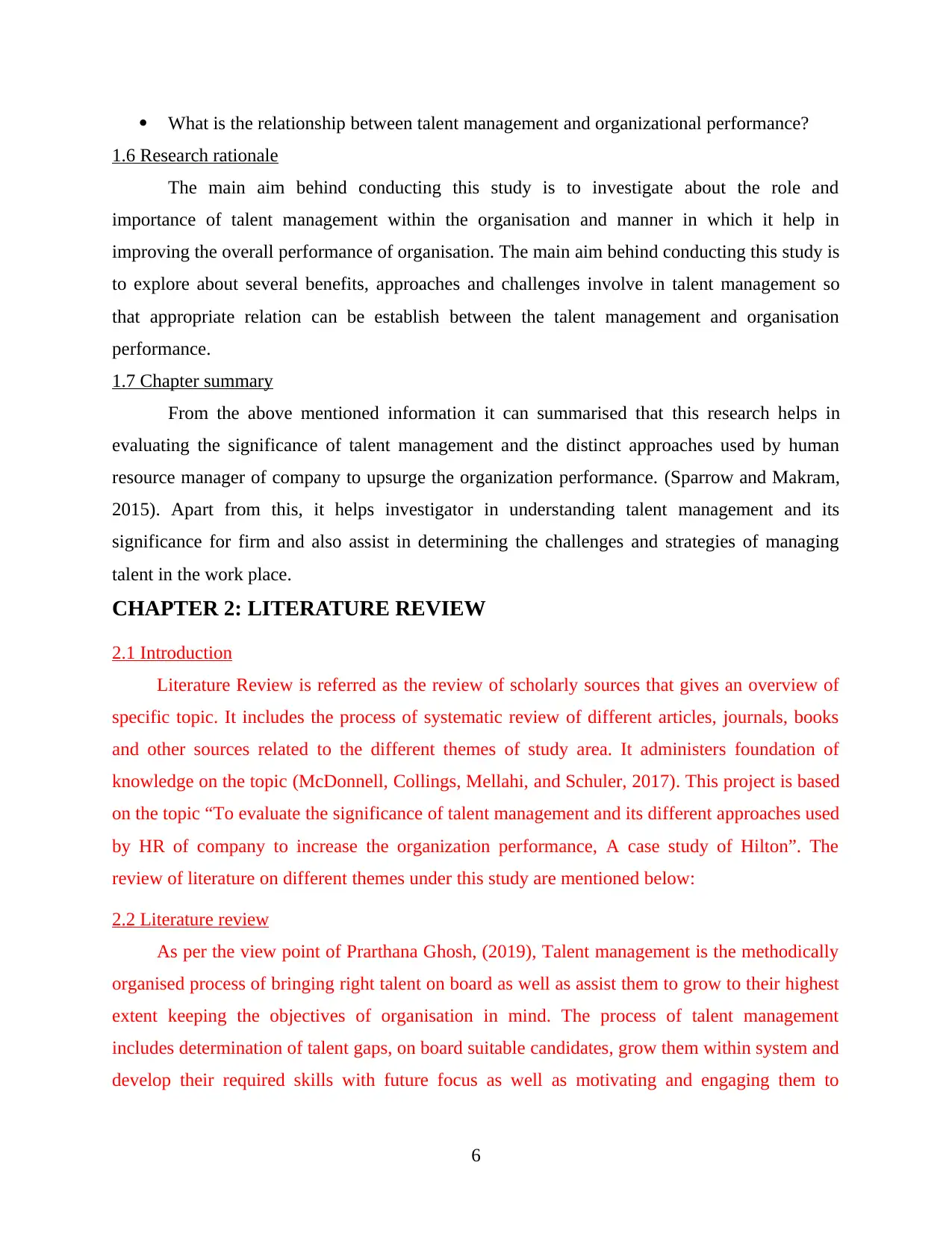
What is the relationship between talent management and organizational performance?
1.6 Research rationale
The main aim behind conducting this study is to investigate about the role and
importance of talent management within the organisation and manner in which it help in
improving the overall performance of organisation. The main aim behind conducting this study is
to explore about several benefits, approaches and challenges involve in talent management so
that appropriate relation can be establish between the talent management and organisation
performance.
1.7 Chapter summary
From the above mentioned information it can summarised that this research helps in
evaluating the significance of talent management and the distinct approaches used by human
resource manager of company to upsurge the organization performance. (Sparrow and Makram,
2015). Apart from this, it helps investigator in understanding talent management and its
significance for firm and also assist in determining the challenges and strategies of managing
talent in the work place.
CHAPTER 2: LITERATURE REVIEW
2.1 Introduction
Literature Review is referred as the review of scholarly sources that gives an overview of
specific topic. It includes the process of systematic review of different articles, journals, books
and other sources related to the different themes of study area. It administers foundation of
knowledge on the topic (McDonnell, Collings, Mellahi, and Schuler, 2017). This project is based
on the topic “To evaluate the significance of talent management and its different approaches used
by HR of company to increase the organization performance, A case study of Hilton”. The
review of literature on different themes under this study are mentioned below:
2.2 Literature review
As per the view point of Prarthana Ghosh, (2019), Talent management is the methodically
organised process of bringing right talent on board as well as assist them to grow to their highest
extent keeping the objectives of organisation in mind. The process of talent management
includes determination of talent gaps, on board suitable candidates, grow them within system and
develop their required skills with future focus as well as motivating and engaging them to
6
1.6 Research rationale
The main aim behind conducting this study is to investigate about the role and
importance of talent management within the organisation and manner in which it help in
improving the overall performance of organisation. The main aim behind conducting this study is
to explore about several benefits, approaches and challenges involve in talent management so
that appropriate relation can be establish between the talent management and organisation
performance.
1.7 Chapter summary
From the above mentioned information it can summarised that this research helps in
evaluating the significance of talent management and the distinct approaches used by human
resource manager of company to upsurge the organization performance. (Sparrow and Makram,
2015). Apart from this, it helps investigator in understanding talent management and its
significance for firm and also assist in determining the challenges and strategies of managing
talent in the work place.
CHAPTER 2: LITERATURE REVIEW
2.1 Introduction
Literature Review is referred as the review of scholarly sources that gives an overview of
specific topic. It includes the process of systematic review of different articles, journals, books
and other sources related to the different themes of study area. It administers foundation of
knowledge on the topic (McDonnell, Collings, Mellahi, and Schuler, 2017). This project is based
on the topic “To evaluate the significance of talent management and its different approaches used
by HR of company to increase the organization performance, A case study of Hilton”. The
review of literature on different themes under this study are mentioned below:
2.2 Literature review
As per the view point of Prarthana Ghosh, (2019), Talent management is the methodically
organised process of bringing right talent on board as well as assist them to grow to their highest
extent keeping the objectives of organisation in mind. The process of talent management
includes determination of talent gaps, on board suitable candidates, grow them within system and
develop their required skills with future focus as well as motivating and engaging them to
6
⊘ This is a preview!⊘
Do you want full access?
Subscribe today to unlock all pages.

Trusted by 1+ million students worldwide
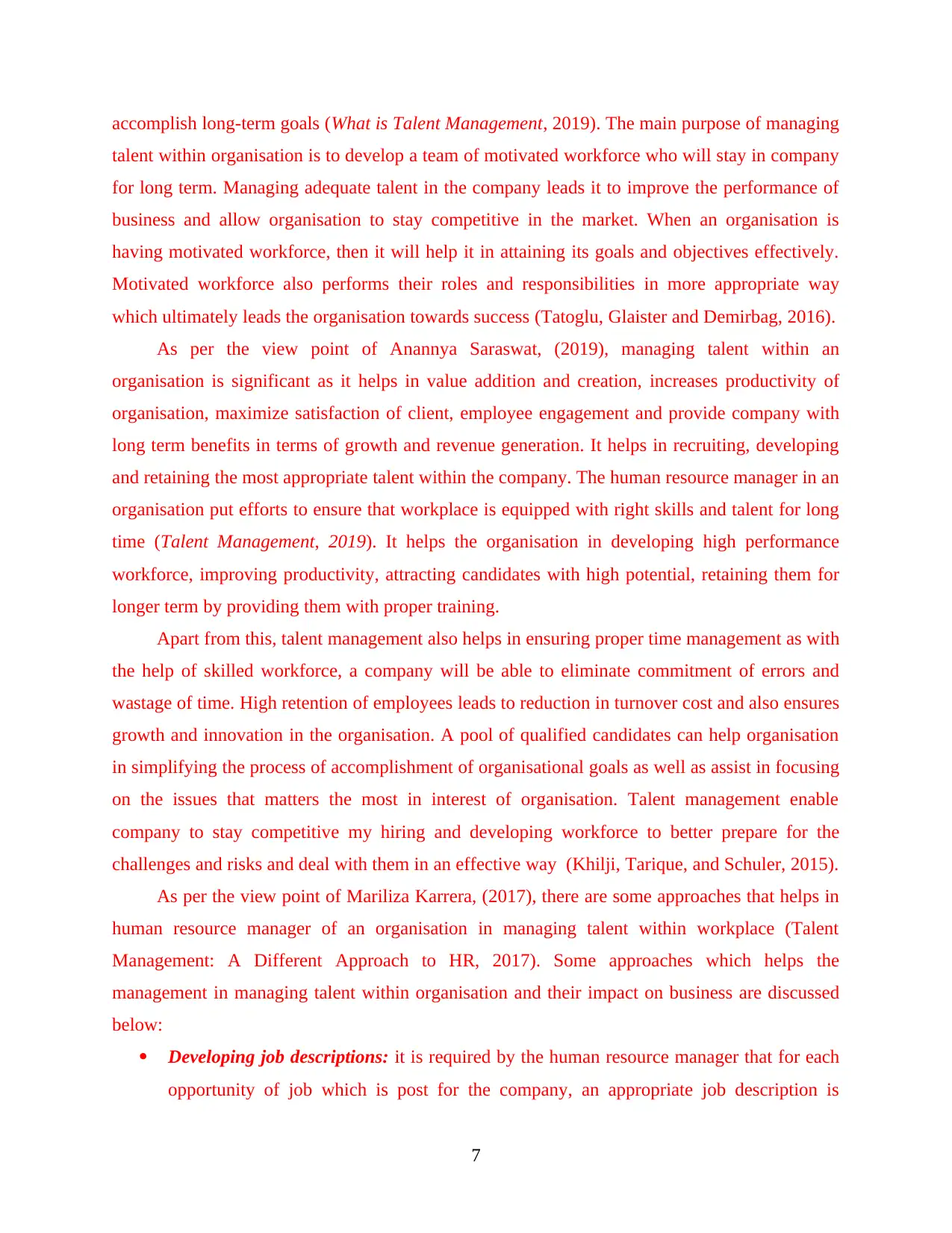
accomplish long-term goals (What is Talent Management, 2019). The main purpose of managing
talent within organisation is to develop a team of motivated workforce who will stay in company
for long term. Managing adequate talent in the company leads it to improve the performance of
business and allow organisation to stay competitive in the market. When an organisation is
having motivated workforce, then it will help it in attaining its goals and objectives effectively.
Motivated workforce also performs their roles and responsibilities in more appropriate way
which ultimately leads the organisation towards success (Tatoglu, Glaister and Demirbag, 2016).
As per the view point of Anannya Saraswat, (2019), managing talent within an
organisation is significant as it helps in value addition and creation, increases productivity of
organisation, maximize satisfaction of client, employee engagement and provide company with
long term benefits in terms of growth and revenue generation. It helps in recruiting, developing
and retaining the most appropriate talent within the company. The human resource manager in an
organisation put efforts to ensure that workplace is equipped with right skills and talent for long
time (Talent Management, 2019). It helps the organisation in developing high performance
workforce, improving productivity, attracting candidates with high potential, retaining them for
longer term by providing them with proper training.
Apart from this, talent management also helps in ensuring proper time management as with
the help of skilled workforce, a company will be able to eliminate commitment of errors and
wastage of time. High retention of employees leads to reduction in turnover cost and also ensures
growth and innovation in the organisation. A pool of qualified candidates can help organisation
in simplifying the process of accomplishment of organisational goals as well as assist in focusing
on the issues that matters the most in interest of organisation. Talent management enable
company to stay competitive my hiring and developing workforce to better prepare for the
challenges and risks and deal with them in an effective way (Khilji, Tarique, and Schuler, 2015).
As per the view point of Mariliza Karrera, (2017), there are some approaches that helps in
human resource manager of an organisation in managing talent within workplace (Talent
Management: A Different Approach to HR, 2017). Some approaches which helps the
management in managing talent within organisation and their impact on business are discussed
below:
Developing job descriptions: it is required by the human resource manager that for each
opportunity of job which is post for the company, an appropriate job description is
7
talent within organisation is to develop a team of motivated workforce who will stay in company
for long term. Managing adequate talent in the company leads it to improve the performance of
business and allow organisation to stay competitive in the market. When an organisation is
having motivated workforce, then it will help it in attaining its goals and objectives effectively.
Motivated workforce also performs their roles and responsibilities in more appropriate way
which ultimately leads the organisation towards success (Tatoglu, Glaister and Demirbag, 2016).
As per the view point of Anannya Saraswat, (2019), managing talent within an
organisation is significant as it helps in value addition and creation, increases productivity of
organisation, maximize satisfaction of client, employee engagement and provide company with
long term benefits in terms of growth and revenue generation. It helps in recruiting, developing
and retaining the most appropriate talent within the company. The human resource manager in an
organisation put efforts to ensure that workplace is equipped with right skills and talent for long
time (Talent Management, 2019). It helps the organisation in developing high performance
workforce, improving productivity, attracting candidates with high potential, retaining them for
longer term by providing them with proper training.
Apart from this, talent management also helps in ensuring proper time management as with
the help of skilled workforce, a company will be able to eliminate commitment of errors and
wastage of time. High retention of employees leads to reduction in turnover cost and also ensures
growth and innovation in the organisation. A pool of qualified candidates can help organisation
in simplifying the process of accomplishment of organisational goals as well as assist in focusing
on the issues that matters the most in interest of organisation. Talent management enable
company to stay competitive my hiring and developing workforce to better prepare for the
challenges and risks and deal with them in an effective way (Khilji, Tarique, and Schuler, 2015).
As per the view point of Mariliza Karrera, (2017), there are some approaches that helps in
human resource manager of an organisation in managing talent within workplace (Talent
Management: A Different Approach to HR, 2017). Some approaches which helps the
management in managing talent within organisation and their impact on business are discussed
below:
Developing job descriptions: it is required by the human resource manager that for each
opportunity of job which is post for the company, an appropriate job description is
7
Paraphrase This Document
Need a fresh take? Get an instant paraphrase of this document with our AI Paraphraser
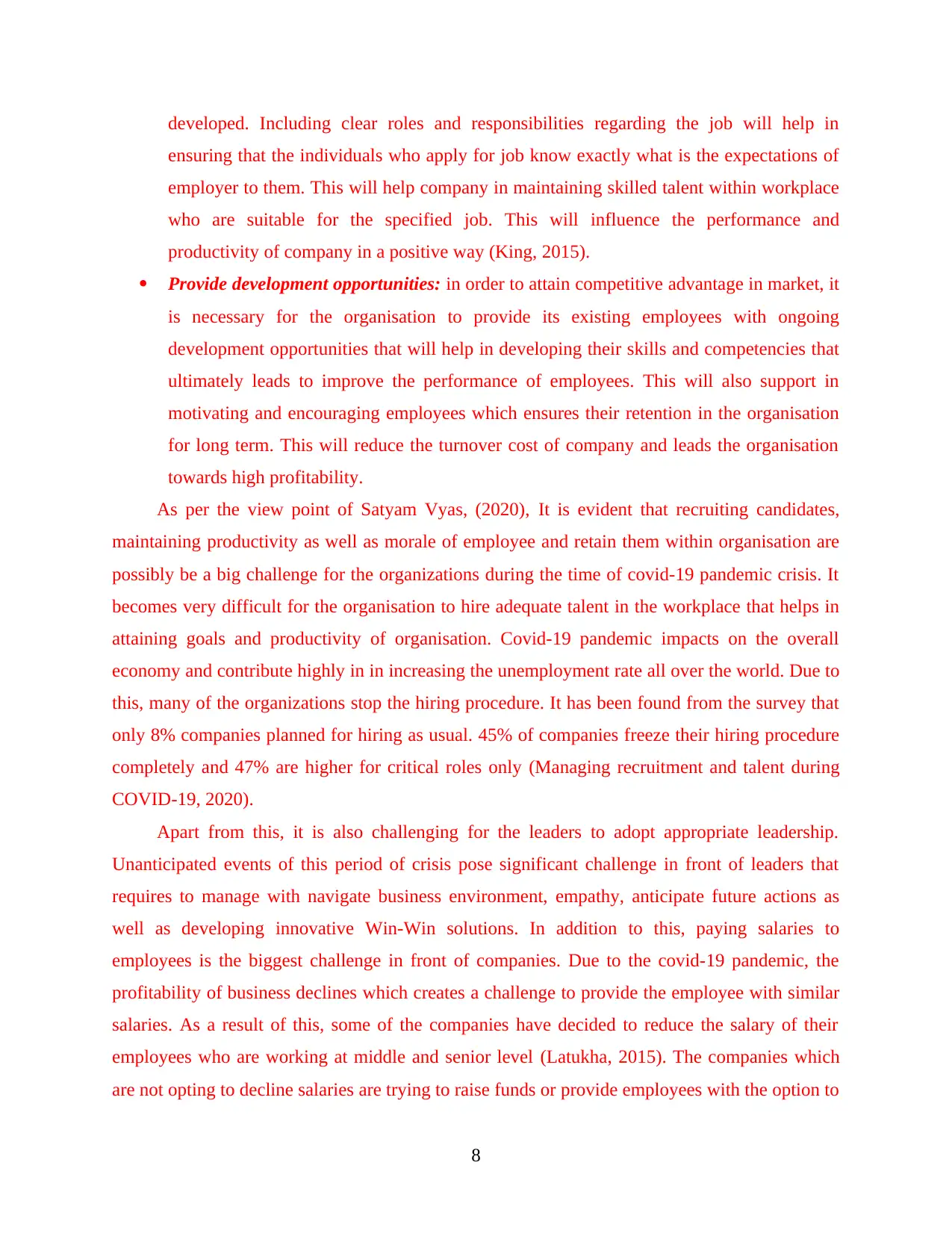
developed. Including clear roles and responsibilities regarding the job will help in
ensuring that the individuals who apply for job know exactly what is the expectations of
employer to them. This will help company in maintaining skilled talent within workplace
who are suitable for the specified job. This will influence the performance and
productivity of company in a positive way (King, 2015).
Provide development opportunities: in order to attain competitive advantage in market, it
is necessary for the organisation to provide its existing employees with ongoing
development opportunities that will help in developing their skills and competencies that
ultimately leads to improve the performance of employees. This will also support in
motivating and encouraging employees which ensures their retention in the organisation
for long term. This will reduce the turnover cost of company and leads the organisation
towards high profitability.
As per the view point of Satyam Vyas, (2020), It is evident that recruiting candidates,
maintaining productivity as well as morale of employee and retain them within organisation are
possibly be a big challenge for the organizations during the time of covid-19 pandemic crisis. It
becomes very difficult for the organisation to hire adequate talent in the workplace that helps in
attaining goals and productivity of organisation. Covid-19 pandemic impacts on the overall
economy and contribute highly in in increasing the unemployment rate all over the world. Due to
this, many of the organizations stop the hiring procedure. It has been found from the survey that
only 8% companies planned for hiring as usual. 45% of companies freeze their hiring procedure
completely and 47% are higher for critical roles only (Managing recruitment and talent during
COVID-19, 2020).
Apart from this, it is also challenging for the leaders to adopt appropriate leadership.
Unanticipated events of this period of crisis pose significant challenge in front of leaders that
requires to manage with navigate business environment, empathy, anticipate future actions as
well as developing innovative Win-Win solutions. In addition to this, paying salaries to
employees is the biggest challenge in front of companies. Due to the covid-19 pandemic, the
profitability of business declines which creates a challenge to provide the employee with similar
salaries. As a result of this, some of the companies have decided to reduce the salary of their
employees who are working at middle and senior level (Latukha, 2015). The companies which
are not opting to decline salaries are trying to raise funds or provide employees with the option to
8
ensuring that the individuals who apply for job know exactly what is the expectations of
employer to them. This will help company in maintaining skilled talent within workplace
who are suitable for the specified job. This will influence the performance and
productivity of company in a positive way (King, 2015).
Provide development opportunities: in order to attain competitive advantage in market, it
is necessary for the organisation to provide its existing employees with ongoing
development opportunities that will help in developing their skills and competencies that
ultimately leads to improve the performance of employees. This will also support in
motivating and encouraging employees which ensures their retention in the organisation
for long term. This will reduce the turnover cost of company and leads the organisation
towards high profitability.
As per the view point of Satyam Vyas, (2020), It is evident that recruiting candidates,
maintaining productivity as well as morale of employee and retain them within organisation are
possibly be a big challenge for the organizations during the time of covid-19 pandemic crisis. It
becomes very difficult for the organisation to hire adequate talent in the workplace that helps in
attaining goals and productivity of organisation. Covid-19 pandemic impacts on the overall
economy and contribute highly in in increasing the unemployment rate all over the world. Due to
this, many of the organizations stop the hiring procedure. It has been found from the survey that
only 8% companies planned for hiring as usual. 45% of companies freeze their hiring procedure
completely and 47% are higher for critical roles only (Managing recruitment and talent during
COVID-19, 2020).
Apart from this, it is also challenging for the leaders to adopt appropriate leadership.
Unanticipated events of this period of crisis pose significant challenge in front of leaders that
requires to manage with navigate business environment, empathy, anticipate future actions as
well as developing innovative Win-Win solutions. In addition to this, paying salaries to
employees is the biggest challenge in front of companies. Due to the covid-19 pandemic, the
profitability of business declines which creates a challenge to provide the employee with similar
salaries. As a result of this, some of the companies have decided to reduce the salary of their
employees who are working at middle and senior level (Latukha, 2015). The companies which
are not opting to decline salaries are trying to raise funds or provide employees with the option to
8
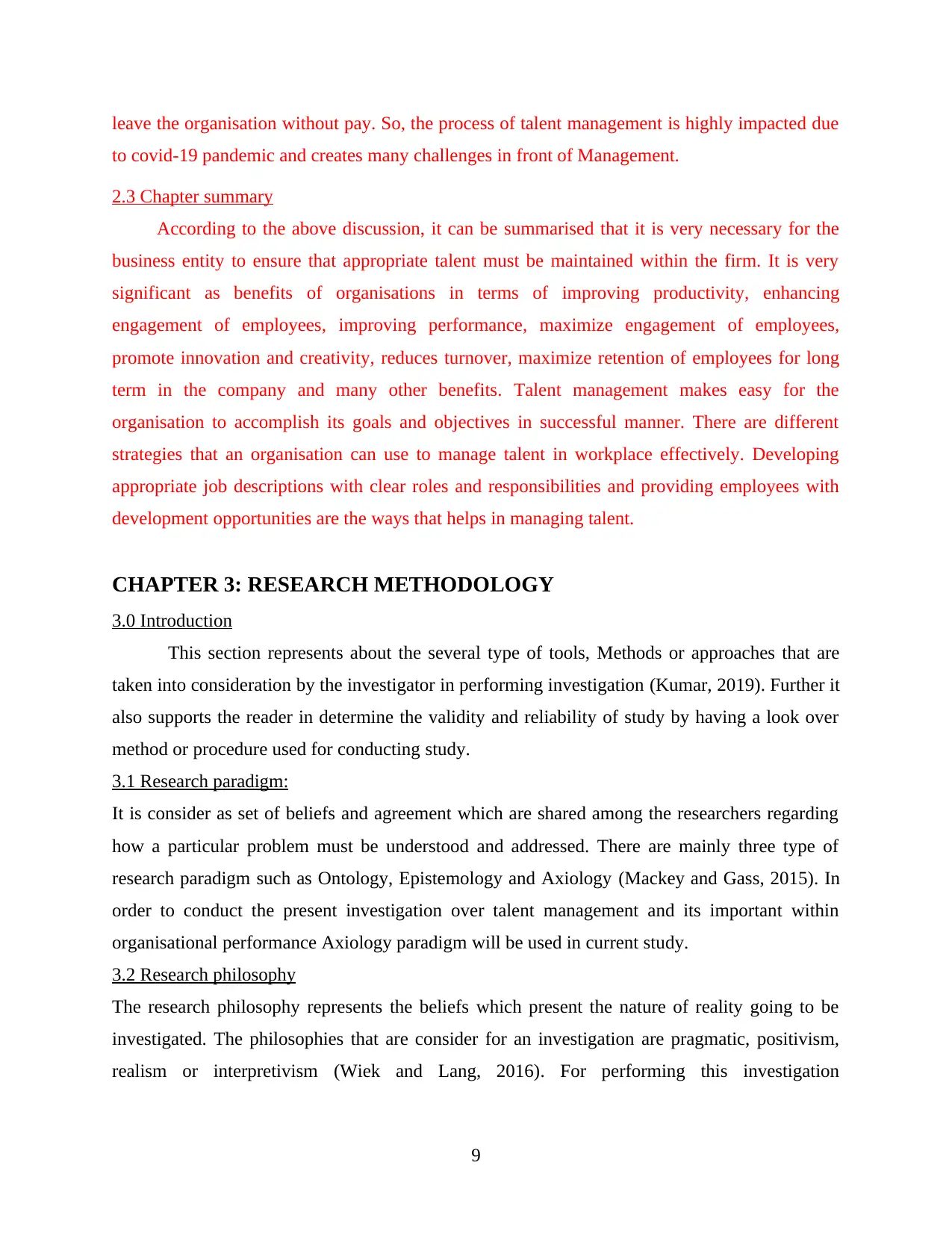
leave the organisation without pay. So, the process of talent management is highly impacted due
to covid-19 pandemic and creates many challenges in front of Management.
2.3 Chapter summary
According to the above discussion, it can be summarised that it is very necessary for the
business entity to ensure that appropriate talent must be maintained within the firm. It is very
significant as benefits of organisations in terms of improving productivity, enhancing
engagement of employees, improving performance, maximize engagement of employees,
promote innovation and creativity, reduces turnover, maximize retention of employees for long
term in the company and many other benefits. Talent management makes easy for the
organisation to accomplish its goals and objectives in successful manner. There are different
strategies that an organisation can use to manage talent in workplace effectively. Developing
appropriate job descriptions with clear roles and responsibilities and providing employees with
development opportunities are the ways that helps in managing talent.
CHAPTER 3: RESEARCH METHODOLOGY
3.0 Introduction
This section represents about the several type of tools, Methods or approaches that are
taken into consideration by the investigator in performing investigation (Kumar, 2019). Further it
also supports the reader in determine the validity and reliability of study by having a look over
method or procedure used for conducting study.
3.1 Research paradigm:
It is consider as set of beliefs and agreement which are shared among the researchers regarding
how a particular problem must be understood and addressed. There are mainly three type of
research paradigm such as Ontology, Epistemology and Axiology (Mackey and Gass, 2015). In
order to conduct the present investigation over talent management and its important within
organisational performance Axiology paradigm will be used in current study.
3.2 Research philosophy
The research philosophy represents the beliefs which present the nature of reality going to be
investigated. The philosophies that are consider for an investigation are pragmatic, positivism,
realism or interpretivism (Wiek and Lang, 2016). For performing this investigation
9
to covid-19 pandemic and creates many challenges in front of Management.
2.3 Chapter summary
According to the above discussion, it can be summarised that it is very necessary for the
business entity to ensure that appropriate talent must be maintained within the firm. It is very
significant as benefits of organisations in terms of improving productivity, enhancing
engagement of employees, improving performance, maximize engagement of employees,
promote innovation and creativity, reduces turnover, maximize retention of employees for long
term in the company and many other benefits. Talent management makes easy for the
organisation to accomplish its goals and objectives in successful manner. There are different
strategies that an organisation can use to manage talent in workplace effectively. Developing
appropriate job descriptions with clear roles and responsibilities and providing employees with
development opportunities are the ways that helps in managing talent.
CHAPTER 3: RESEARCH METHODOLOGY
3.0 Introduction
This section represents about the several type of tools, Methods or approaches that are
taken into consideration by the investigator in performing investigation (Kumar, 2019). Further it
also supports the reader in determine the validity and reliability of study by having a look over
method or procedure used for conducting study.
3.1 Research paradigm:
It is consider as set of beliefs and agreement which are shared among the researchers regarding
how a particular problem must be understood and addressed. There are mainly three type of
research paradigm such as Ontology, Epistemology and Axiology (Mackey and Gass, 2015). In
order to conduct the present investigation over talent management and its important within
organisational performance Axiology paradigm will be used in current study.
3.2 Research philosophy
The research philosophy represents the beliefs which present the nature of reality going to be
investigated. The philosophies that are consider for an investigation are pragmatic, positivism,
realism or interpretivism (Wiek and Lang, 2016). For performing this investigation
9
⊘ This is a preview!⊘
Do you want full access?
Subscribe today to unlock all pages.

Trusted by 1+ million students worldwide
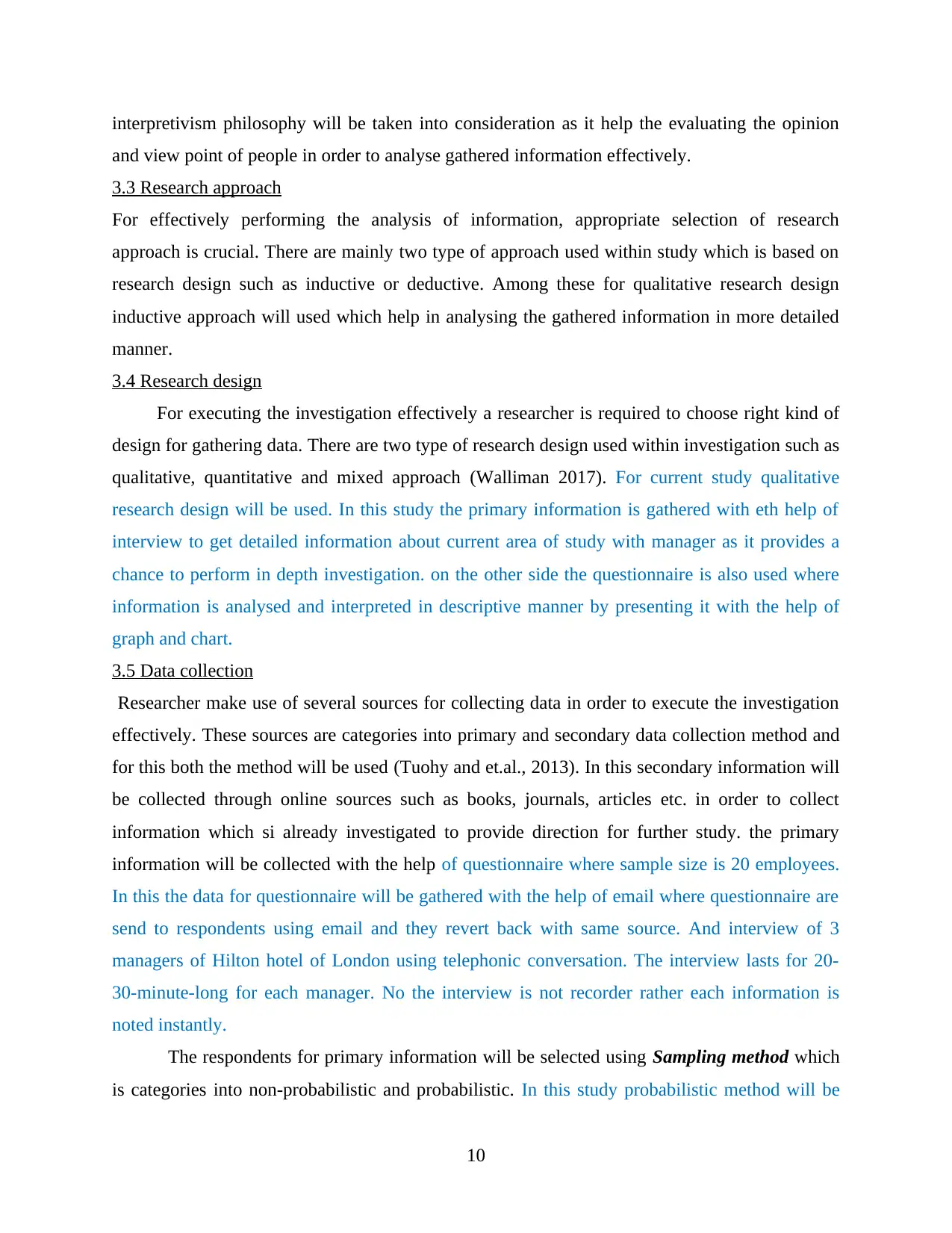
interpretivism philosophy will be taken into consideration as it help the evaluating the opinion
and view point of people in order to analyse gathered information effectively.
3.3 Research approach
For effectively performing the analysis of information, appropriate selection of research
approach is crucial. There are mainly two type of approach used within study which is based on
research design such as inductive or deductive. Among these for qualitative research design
inductive approach will used which help in analysing the gathered information in more detailed
manner.
3.4 Research design
For executing the investigation effectively a researcher is required to choose right kind of
design for gathering data. There are two type of research design used within investigation such as
qualitative, quantitative and mixed approach (Walliman 2017). For current study qualitative
research design will be used. In this study the primary information is gathered with eth help of
interview to get detailed information about current area of study with manager as it provides a
chance to perform in depth investigation. on the other side the questionnaire is also used where
information is analysed and interpreted in descriptive manner by presenting it with the help of
graph and chart.
3.5 Data collection
Researcher make use of several sources for collecting data in order to execute the investigation
effectively. These sources are categories into primary and secondary data collection method and
for this both the method will be used (Tuohy and et.al., 2013). In this secondary information will
be collected through online sources such as books, journals, articles etc. in order to collect
information which si already investigated to provide direction for further study. the primary
information will be collected with the help of questionnaire where sample size is 20 employees.
In this the data for questionnaire will be gathered with the help of email where questionnaire are
send to respondents using email and they revert back with same source. And interview of 3
managers of Hilton hotel of London using telephonic conversation. The interview lasts for 20-
30-minute-long for each manager. No the interview is not recorder rather each information is
noted instantly.
The respondents for primary information will be selected using Sampling method which
is categories into non-probabilistic and probabilistic. In this study probabilistic method will be
10
and view point of people in order to analyse gathered information effectively.
3.3 Research approach
For effectively performing the analysis of information, appropriate selection of research
approach is crucial. There are mainly two type of approach used within study which is based on
research design such as inductive or deductive. Among these for qualitative research design
inductive approach will used which help in analysing the gathered information in more detailed
manner.
3.4 Research design
For executing the investigation effectively a researcher is required to choose right kind of
design for gathering data. There are two type of research design used within investigation such as
qualitative, quantitative and mixed approach (Walliman 2017). For current study qualitative
research design will be used. In this study the primary information is gathered with eth help of
interview to get detailed information about current area of study with manager as it provides a
chance to perform in depth investigation. on the other side the questionnaire is also used where
information is analysed and interpreted in descriptive manner by presenting it with the help of
graph and chart.
3.5 Data collection
Researcher make use of several sources for collecting data in order to execute the investigation
effectively. These sources are categories into primary and secondary data collection method and
for this both the method will be used (Tuohy and et.al., 2013). In this secondary information will
be collected through online sources such as books, journals, articles etc. in order to collect
information which si already investigated to provide direction for further study. the primary
information will be collected with the help of questionnaire where sample size is 20 employees.
In this the data for questionnaire will be gathered with the help of email where questionnaire are
send to respondents using email and they revert back with same source. And interview of 3
managers of Hilton hotel of London using telephonic conversation. The interview lasts for 20-
30-minute-long for each manager. No the interview is not recorder rather each information is
noted instantly.
The respondents for primary information will be selected using Sampling method which
is categories into non-probabilistic and probabilistic. In this study probabilistic method will be
10
Paraphrase This Document
Need a fresh take? Get an instant paraphrase of this document with our AI Paraphraser
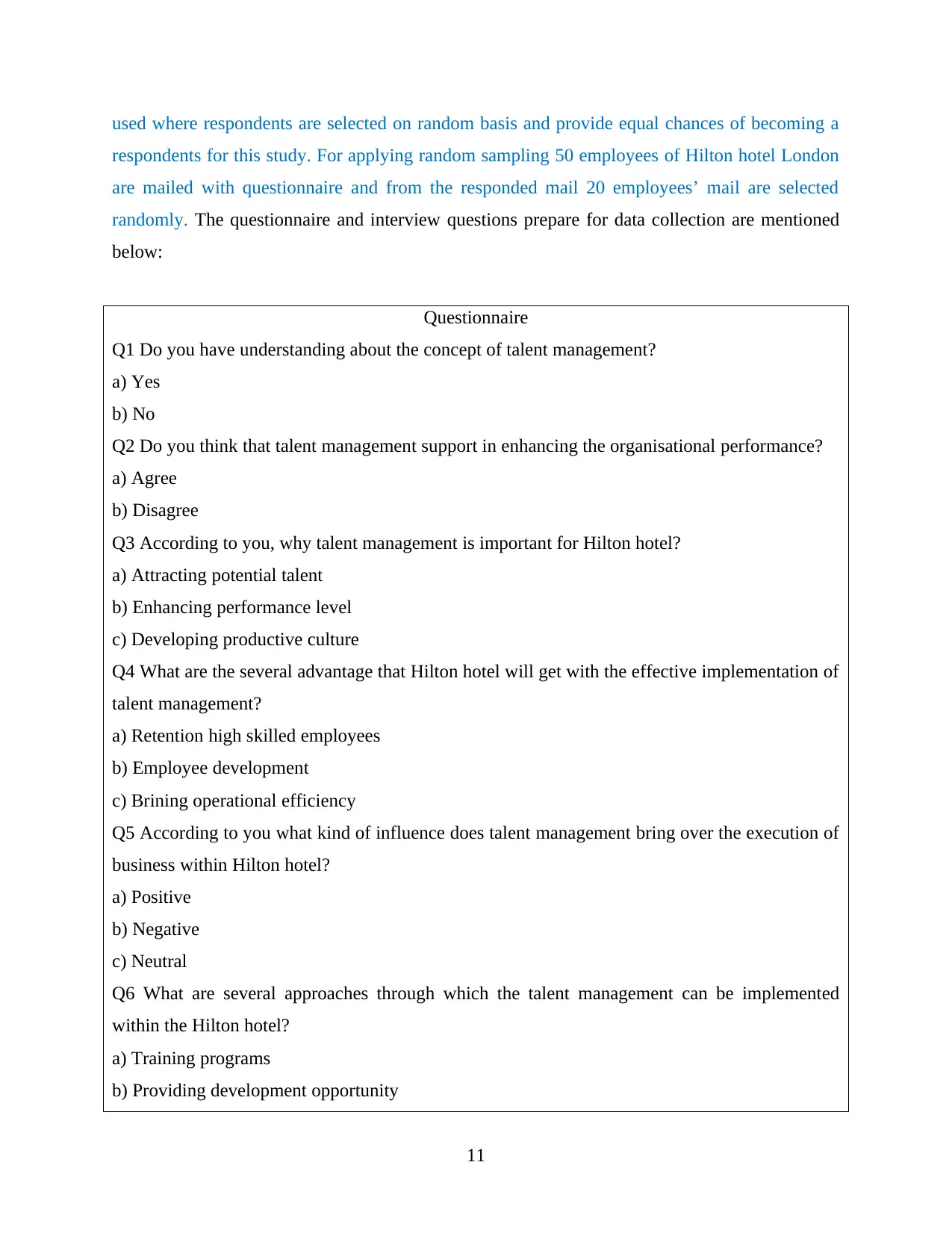
used where respondents are selected on random basis and provide equal chances of becoming a
respondents for this study. For applying random sampling 50 employees of Hilton hotel London
are mailed with questionnaire and from the responded mail 20 employees’ mail are selected
randomly. The questionnaire and interview questions prepare for data collection are mentioned
below:
Questionnaire
Q1 Do you have understanding about the concept of talent management?
a) Yes
b) No
Q2 Do you think that talent management support in enhancing the organisational performance?
a) Agree
b) Disagree
Q3 According to you, why talent management is important for Hilton hotel?
a) Attracting potential talent
b) Enhancing performance level
c) Developing productive culture
Q4 What are the several advantage that Hilton hotel will get with the effective implementation of
talent management?
a) Retention high skilled employees
b) Employee development
c) Brining operational efficiency
Q5 According to you what kind of influence does talent management bring over the execution of
business within Hilton hotel?
a) Positive
b) Negative
c) Neutral
Q6 What are several approaches through which the talent management can be implemented
within the Hilton hotel?
a) Training programs
b) Providing development opportunity
11
respondents for this study. For applying random sampling 50 employees of Hilton hotel London
are mailed with questionnaire and from the responded mail 20 employees’ mail are selected
randomly. The questionnaire and interview questions prepare for data collection are mentioned
below:
Questionnaire
Q1 Do you have understanding about the concept of talent management?
a) Yes
b) No
Q2 Do you think that talent management support in enhancing the organisational performance?
a) Agree
b) Disagree
Q3 According to you, why talent management is important for Hilton hotel?
a) Attracting potential talent
b) Enhancing performance level
c) Developing productive culture
Q4 What are the several advantage that Hilton hotel will get with the effective implementation of
talent management?
a) Retention high skilled employees
b) Employee development
c) Brining operational efficiency
Q5 According to you what kind of influence does talent management bring over the execution of
business within Hilton hotel?
a) Positive
b) Negative
c) Neutral
Q6 What are several approaches through which the talent management can be implemented
within the Hilton hotel?
a) Training programs
b) Providing development opportunity
11
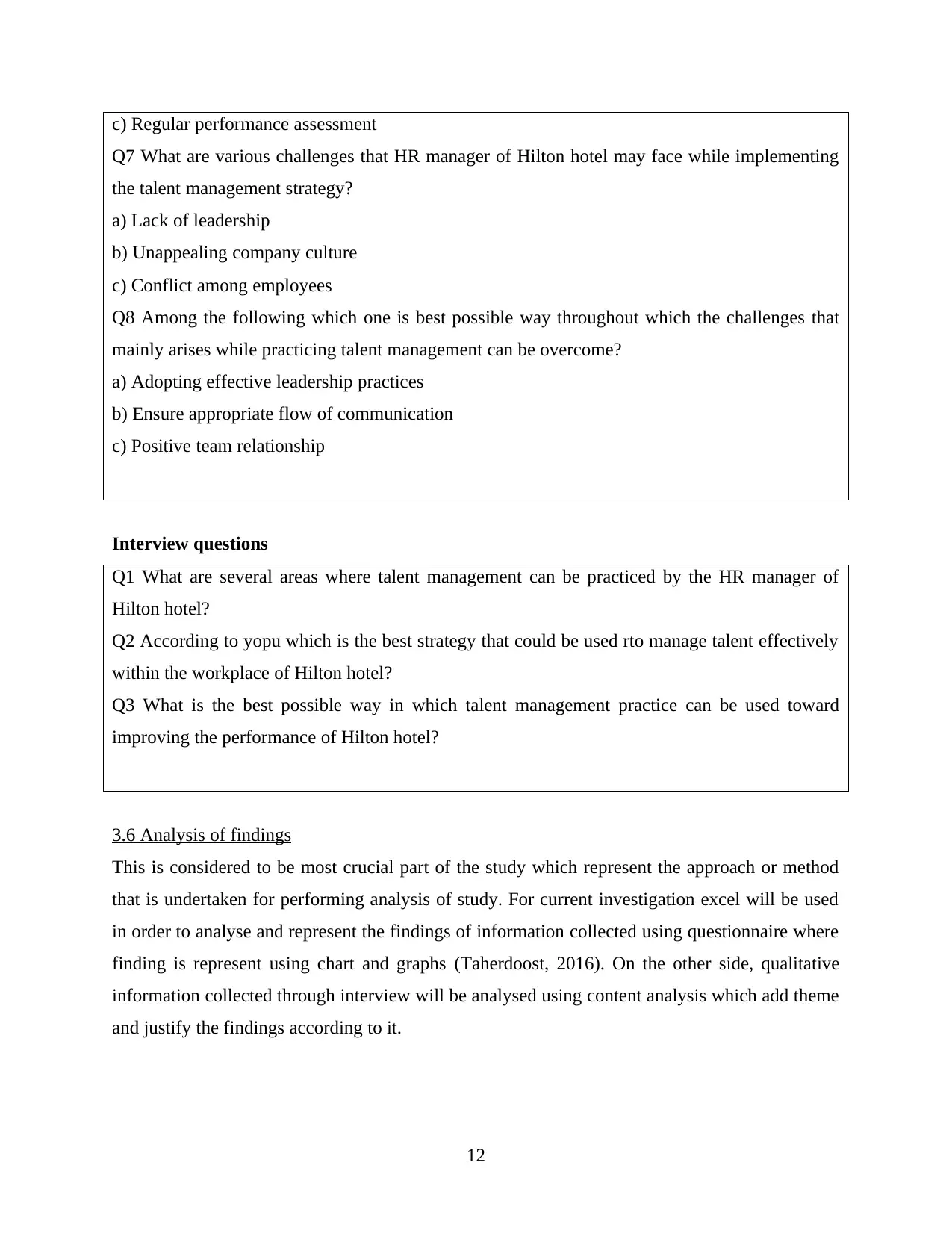
c) Regular performance assessment
Q7 What are various challenges that HR manager of Hilton hotel may face while implementing
the talent management strategy?
a) Lack of leadership
b) Unappealing company culture
c) Conflict among employees
Q8 Among the following which one is best possible way throughout which the challenges that
mainly arises while practicing talent management can be overcome?
a) Adopting effective leadership practices
b) Ensure appropriate flow of communication
c) Positive team relationship
Interview questions
Q1 What are several areas where talent management can be practiced by the HR manager of
Hilton hotel?
Q2 According to yopu which is the best strategy that could be used rto manage talent effectively
within the workplace of Hilton hotel?
Q3 What is the best possible way in which talent management practice can be used toward
improving the performance of Hilton hotel?
3.6 Analysis of findings
This is considered to be most crucial part of the study which represent the approach or method
that is undertaken for performing analysis of study. For current investigation excel will be used
in order to analyse and represent the findings of information collected using questionnaire where
finding is represent using chart and graphs (Taherdoost, 2016). On the other side, qualitative
information collected through interview will be analysed using content analysis which add theme
and justify the findings according to it.
12
Q7 What are various challenges that HR manager of Hilton hotel may face while implementing
the talent management strategy?
a) Lack of leadership
b) Unappealing company culture
c) Conflict among employees
Q8 Among the following which one is best possible way throughout which the challenges that
mainly arises while practicing talent management can be overcome?
a) Adopting effective leadership practices
b) Ensure appropriate flow of communication
c) Positive team relationship
Interview questions
Q1 What are several areas where talent management can be practiced by the HR manager of
Hilton hotel?
Q2 According to yopu which is the best strategy that could be used rto manage talent effectively
within the workplace of Hilton hotel?
Q3 What is the best possible way in which talent management practice can be used toward
improving the performance of Hilton hotel?
3.6 Analysis of findings
This is considered to be most crucial part of the study which represent the approach or method
that is undertaken for performing analysis of study. For current investigation excel will be used
in order to analyse and represent the findings of information collected using questionnaire where
finding is represent using chart and graphs (Taherdoost, 2016). On the other side, qualitative
information collected through interview will be analysed using content analysis which add theme
and justify the findings according to it.
12
⊘ This is a preview!⊘
Do you want full access?
Subscribe today to unlock all pages.

Trusted by 1+ million students worldwide
1 out of 22
Related Documents
Your All-in-One AI-Powered Toolkit for Academic Success.
+13062052269
info@desklib.com
Available 24*7 on WhatsApp / Email
![[object Object]](/_next/static/media/star-bottom.7253800d.svg)
Unlock your academic potential
Copyright © 2020–2025 A2Z Services. All Rights Reserved. Developed and managed by ZUCOL.




